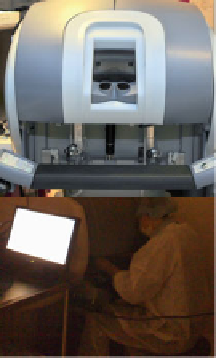Information Technology Reference
In-Depth Information
After initial manual preparation during surgery, this milling plan was executed
automatically. After the milling, the surgery proceeded without the robot for the
remaining portion. A contemporary robotic system for orthopedic surgery (the
German CASPER system [
10
]) used a similar clinical work
fl
ow as the ROBODOC
and was also not successful.
Similarly, the contemporary FDA-approved neurosurgery system (the NEU-
ROMATE; Fig.
2
, left) too was not widely applied clinically [
11
] and now exists
primarily for use in further research and development. The reviews [
12
,
13
] detail
other early orthopedic robotic research applications. By the turn of the century,
robotics research was receiving active attention for many other surgical specialties,
such as eye surgery (the JHU
“
steady-hand
”
system [
14
]) that have also yet to be
commercialized.
By comparison, led by successful robotic systems such as the AESOP (Com-
puter Motion, Inc; now owned by Intuitive Surgical, Inc) camera assistants [
15
] for
laparoscopic procedures (a modi
ed SCARA architecture, with a passive remote
center of motion), robots have achieved a much greater user acceptance. Other
robotic surgery systems including the MIRO system [
16
] or the University of
Washington RAVEN prototypes, and commercial complete general laparoscopic
surgery robotic systems such as the da Vinci telerobotic system (Fig.
3
)[
17
19
].
The da Vinci Surgical system (Fig.
3
) remains the dominant commercially
available telerobotic minimally invasive surgery system. This telerobotic system
-
Slave manipulators
stereo viewer
Removable surgical
instruments
hand rest and master controls
Fig. 3
The da Vinci surgical system (Intuitive Surgical, Inc.): a
first-generation slave (patient-side
manipulators) setup for a training session (left), and a second-generation master console (right,
top) and the system in use by a trainee surgeon and bottom. Until the introduction of near infrared
fluorescence integration recently, only visual imaging was available for feedback to the surgeon.
Any additional imaging was viewable as a video (picture in picture) piped from external consoles
(right bottom). A new version of the da Vinci system
has been introduced in
2014 that significantly improves positioning of the surgical instruments over the patient and
reduces the operating room footprint
—
the da Vinci Xi
—




